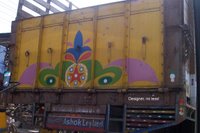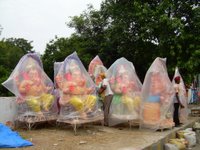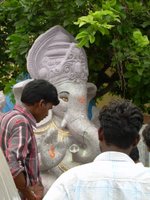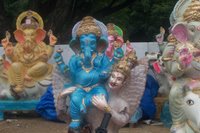In India too, we have lorry drivers who love their vehicles so much that they personalize every inch of their lorries. You just need to look, and you will find every paint-able part of lorries painted in several bright colours with a variety of motifs, words, and messages. The words could be just a simple, ‘Please sound horn’ or a ‘Use dipper at night’. Sometimes they could be, in Hindi, Mera Bharat mahaan (My India is great), or in Telugu, Nidaname pradanamu (being slow is of importance). Very often you find names of gods and goddesses (Jai Hanuman) or those of popular films.
I saw a hilarious one that said Buri nazar wale tera mooh kala, a Hindi expression written in Telugu script, which means...‘one with evil eye--may your face turn black’!! Another such was Maa ki duaa (mother’s blessing), again Hindi in Telugu script. Another funny one that I cannot quite figure out says in Telugu, nannu choosi eduvaku raa, which means ‘don’t look at me and cry’! What in the world....?!
Apart from the words, the visuals painted on many lorries are varied and intricate. Lorry art is indeed very interesting and fascinating, and must be recognized as a genre in itself, if it hasn’t already been. Here are some pix of lorries that I took on a few road trips in South India...I am quite certain if one made a collection of lorry photos from all over India, there would be as much diversity of colour and language as there is in the different States.


For some more lorry art, click on http://www.flickr.com/photos/lens_sense/
While on lorries and grafitti, I must mention Harriet Coles, an English friend from the 1980s, from whom I bought my first vehicle---a moped (TVS 50) for Rs 4000. During her stay in India, Harriet had been fascinated by the words written on lorries and had painted some grafitti on this moped...so, my TVS (which btw, I named Heliothis after the insect pest Harriet had been researching on) came to me with ‘King of the road’, ‘Mohammed Ali’, ‘Sholay’, etc. painted wherever there was any space available. It was cute and different, and I loved Heliothis --- grafitti and all ---after all, it was the first vehicle I bought with my own hard-earned money.
It was okay until the day I returned from shopping to my parked moped, to find a cop waiting, only to tell me to erase the grafitti that was ‘only meant for lorries’! He had already scratched out the "King of the road" painted on the number-plate. This seemed so unfair...if lorry drivers could paint grafitti, why couldn’t I? I helplessly looked at the grinning cop and said ‘okay, I will wipe them out...’
But at that moment, all wanted to say to him was: buri nazar wale tera mooh kala!
 Here is a touching tribute to Steve Irwin, sent to me by Giridhar.
Here is a touching tribute to Steve Irwin, sent to me by Giridhar.









